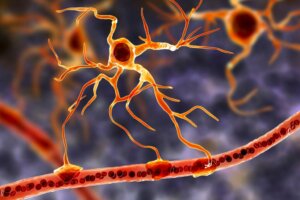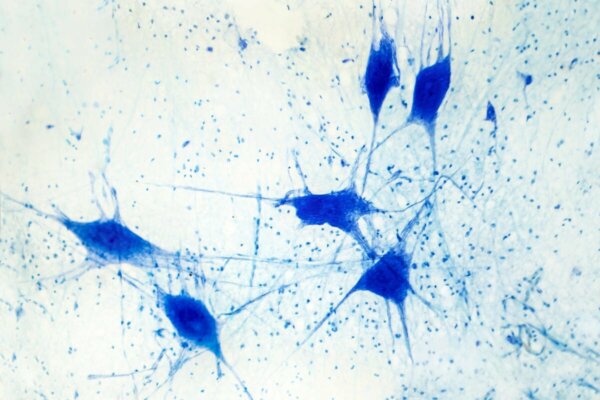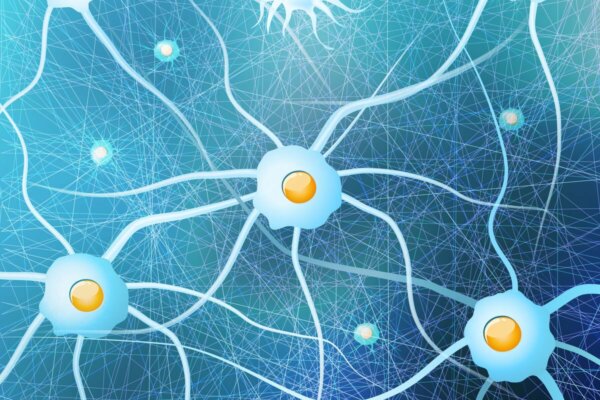Glial Cells: The Functional Basis of the Brain

The brain is one of the most important organs in the body. It allows us to speak, move, feel, and think. Because of its key role, a lot of research in recent years has focused on the brain to understand the different parts that form it and the way they work.
Initially, it was believed that neurons were the only cells in charge of brain activity. However, recent research has highlighted the role glial cells play in brain function. As studies now show, glial cells are fundamental actors process of information transmission. As recent studies show, some of the main brain diseases aren’t only related to neuronal damage. Glial cells also deteriorate as a result of brain disease.

What are glial cells?
You’ll be able to understand the importance of these small cells just by looking at one example. During the course of many different experiments, attempts were made to keep neurons in isolation in culture plates, but they always died within a few days. Later, researchers found that, if they added an extract from the glial cells to the culture medium, they could control the death or survival of the neurons, which highlighted the key role of glial cells in neuron survival.
As studies have found out, we have a very large amount of glial cells or neuroglia. Their name stems from the Greek word “glia” which means “glue”, plus “neuro”, a term related to the brain. In other words, glial cells are the glue of our brain.
Traditionally, it’s been considered that glial cells have a very passive role in the brain, acting only as only metabolic, structural, and trophic support for neurons. However, recent research shows that they have many more functions in various processes that take place in the brain. They often enable the work of other types of neurons.
The functions of glial cells
Glial cells have multiple functions. Some of them are the following:
- Isolation. Glial cells produce a substance called myelin, which is essential for isolating neurons. This dense substance is designed to cover the axons, protecting cells and allowing for information transmission to be fast and efficient. Likewise, it helps to prevent neuronal messages from getting mixed up. Besides, it has a key role in learning. As studies show, when learning processes are taking place, the amount of myelin in our brain increases.
- Source of nutrients. As we know, neurons in the brain consume a good amount of energy. Although they have some nutrient reserves, these aren’t enough to maintain brain activity beyond a few minutes. In this sense, glial cells help supply the nutrients and energy that the neurons lack. They do this by incorporating energy molecules such as glucose, which they get from the blood.
- Cleansing. Glial cells help remove waste products related to neuronal function. They do this in two ways. Firstly, by removing some of the neurotransmitters that remain in the synaptic space, and then transforming them and returning them to the original neuron so that they can once again become raw material for new neurotransmitters. Secondly, they’re responsible for eliminating the remains of dead neurons. This is particularly important when there’s damage to the nervous system. Furthermore, this cleansing action helps to attenuate the chemical and physical effects that these remains can generate.
- Synapse enhancement. The presence of these cells helps to release thrombospondin, which facilitates synapses, in turn boosting synaptic activity.
Types of glial cells
There are different types of glial cells, each of them performing a series of different functions. They all have an important role in neuron and brain function.
There are different ways to classify glial cells. One way of doing this is by looking at their location within the nervous system. This is what we’ll take into account to explain each type.
The central nervous system
Firstly, there are astrocytes. These are large, star-shaped glial cells, which is why they’re referred to as macroglia (large glial cells). These are the most abundant glial cells in the brain. As to their location, they surround the synaptic connections in the brain.
One of their main functions is to define cellular boundaries and contribute to the formation of a defensive barrier for the brain. They also control the formation and functionality of the synapse, neurogenesis, and the regulation of muscle tone. On the other hand, they help feed neurons.
There are also oligodendrocytes. These are macroglia of the central nervous system. Through providing provide cell axons with myelin, they’re key to cell insulation. These cells have the capacity to myelinize more than one neuron and, in some cases, can help regenerate damaged axons.
Finally, there are the microglia, which help in the brain’s cleaning processes. They respond when there’s damage in the system, cleaning the cellular remains and triggering the brain’s inflammatory response.

The peripheral nervous system (PNS)
In this part of the nervous system, the Schwann cells, which are macroglia, take over. These glial cells are divided into three subtypes. The first is the type that forms myelin. As its name indicates, it helps to myelinate the axons, but they can only do it with one axon at a time. When there’s brain damage, they fulfill the function of cleaning and favoring the conditions for regeneration.
Secondly, there are the Schwann cells that don’t form myelin. The way these cells communicate with the axons is currently unknown. Even so, studies show that they are necessary for the function and maintenance of non-myelinated axons, which are essential for generating the sensation of pain.
Thirdly, there are the perisynaptic Schwann cells. These cells cover the neuromuscular connections, releasing neurotransmitters and peptides. The receptors placed in their membrane allow them to generate signals related to these substances. Likewise, they can control and potentiate synapses.
In short, glial cells are a fundamental part of the nervous system. Not only do they support the cells, but they also help in activities such as synapses, cleansing, and the generation of nutrients. Therefore, they have an important influence on the development of some diseases, such as multiple sclerosis.
The brain is one of the most important organs in the body. It allows us to speak, move, feel, and think. Because of its key role, a lot of research in recent years has focused on the brain to understand the different parts that form it and the way they work.
Initially, it was believed that neurons were the only cells in charge of brain activity. However, recent research has highlighted the role glial cells play in brain function. As studies now show, glial cells are fundamental actors process of information transmission. As recent studies show, some of the main brain diseases aren’t only related to neuronal damage. Glial cells also deteriorate as a result of brain disease.

What are glial cells?
You’ll be able to understand the importance of these small cells just by looking at one example. During the course of many different experiments, attempts were made to keep neurons in isolation in culture plates, but they always died within a few days. Later, researchers found that, if they added an extract from the glial cells to the culture medium, they could control the death or survival of the neurons, which highlighted the key role of glial cells in neuron survival.
As studies have found out, we have a very large amount of glial cells or neuroglia. Their name stems from the Greek word “glia” which means “glue”, plus “neuro”, a term related to the brain. In other words, glial cells are the glue of our brain.
Traditionally, it’s been considered that glial cells have a very passive role in the brain, acting only as only metabolic, structural, and trophic support for neurons. However, recent research shows that they have many more functions in various processes that take place in the brain. They often enable the work of other types of neurons.
The functions of glial cells
Glial cells have multiple functions. Some of them are the following:
- Isolation. Glial cells produce a substance called myelin, which is essential for isolating neurons. This dense substance is designed to cover the axons, protecting cells and allowing for information transmission to be fast and efficient. Likewise, it helps to prevent neuronal messages from getting mixed up. Besides, it has a key role in learning. As studies show, when learning processes are taking place, the amount of myelin in our brain increases.
- Source of nutrients. As we know, neurons in the brain consume a good amount of energy. Although they have some nutrient reserves, these aren’t enough to maintain brain activity beyond a few minutes. In this sense, glial cells help supply the nutrients and energy that the neurons lack. They do this by incorporating energy molecules such as glucose, which they get from the blood.
- Cleansing. Glial cells help remove waste products related to neuronal function. They do this in two ways. Firstly, by removing some of the neurotransmitters that remain in the synaptic space, and then transforming them and returning them to the original neuron so that they can once again become raw material for new neurotransmitters. Secondly, they’re responsible for eliminating the remains of dead neurons. This is particularly important when there’s damage to the nervous system. Furthermore, this cleansing action helps to attenuate the chemical and physical effects that these remains can generate.
- Synapse enhancement. The presence of these cells helps to release thrombospondin, which facilitates synapses, in turn boosting synaptic activity.
Types of glial cells
There are different types of glial cells, each of them performing a series of different functions. They all have an important role in neuron and brain function.
There are different ways to classify glial cells. One way of doing this is by looking at their location within the nervous system. This is what we’ll take into account to explain each type.
The central nervous system
Firstly, there are astrocytes. These are large, star-shaped glial cells, which is why they’re referred to as macroglia (large glial cells). These are the most abundant glial cells in the brain. As to their location, they surround the synaptic connections in the brain.
One of their main functions is to define cellular boundaries and contribute to the formation of a defensive barrier for the brain. They also control the formation and functionality of the synapse, neurogenesis, and the regulation of muscle tone. On the other hand, they help feed neurons.
There are also oligodendrocytes. These are macroglia of the central nervous system. Through providing provide cell axons with myelin, they’re key to cell insulation. These cells have the capacity to myelinize more than one neuron and, in some cases, can help regenerate damaged axons.
Finally, there are the microglia, which help in the brain’s cleaning processes. They respond when there’s damage in the system, cleaning the cellular remains and triggering the brain’s inflammatory response.

The peripheral nervous system (PNS)
In this part of the nervous system, the Schwann cells, which are macroglia, take over. These glial cells are divided into three subtypes. The first is the type that forms myelin. As its name indicates, it helps to myelinate the axons, but they can only do it with one axon at a time. When there’s brain damage, they fulfill the function of cleaning and favoring the conditions for regeneration.
Secondly, there are the Schwann cells that don’t form myelin. The way these cells communicate with the axons is currently unknown. Even so, studies show that they are necessary for the function and maintenance of non-myelinated axons, which are essential for generating the sensation of pain.
Thirdly, there are the perisynaptic Schwann cells. These cells cover the neuromuscular connections, releasing neurotransmitters and peptides. The receptors placed in their membrane allow them to generate signals related to these substances. Likewise, they can control and potentiate synapses.
In short, glial cells are a fundamental part of the nervous system. Not only do they support the cells, but they also help in activities such as synapses, cleansing, and the generation of nutrients. Therefore, they have an important influence on the development of some diseases, such as multiple sclerosis.
All cited sources were thoroughly reviewed by our team to ensure their quality, reliability, currency, and validity. The bibliography of this article was considered reliable and of academic or scientific accuracy.
- Martínez-Gómez, A. (2014a). Comunicación entre células gliales y neuronas I. Astrocitos, células de Schwann que no forman mielina y células de Schwann perisinápticas. Revista de Medicina e Investigación, 2(2), 75-84. https://doi.org/10.1016/S2214-3106(15)30002-9
- Castellano y González (2005) Células gliales. Revista mente y cerebro 13, 83-88.
- Martínez-Gómez, A. (2014b). Comunicación entre células gliales y neuronas II. Células gliales que forman mielina. Revista de Medicina e Investigación, 2(2), 85-93. https://doi.org/10.1016/S2214-3106(15)30003-0
- Rela, L. (2016). Células gliales ¿Servidoras de las neuronas o compañeras de equipo? Ciencia hoy, 26 (151), 36-42 http://ri.conicet.gov.ar/handle/11336/48884
This text is provided for informational purposes only and does not replace consultation with a professional. If in doubt, consult your specialist.







